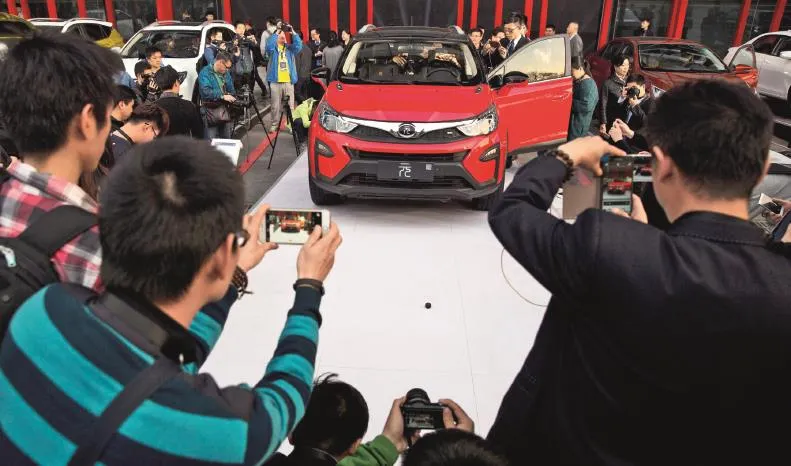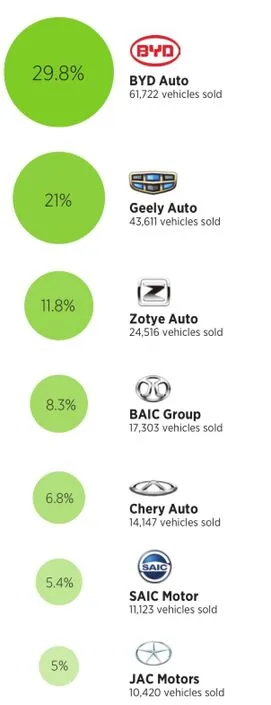China’s New Energy Vehicle Industry Booms
2016-09-26ByChenSijia
By Chen Sijia
China’s New Energy Vehicle Industry Booms
By Chen Sijia

Fans taking pictures of a BYD new-energy vehicle
tesla, an American electric car manufacturer, may be to most the world’s most recognizable brand of new energy cars. It is not however, the world’s best selling-that title goes to China’s Biyadi, also known as BYD.
During the 14th Beijing International Automobile Exhibition’s media day on May 2,auto manufacturers put on a show for reporters from around the world, some even inviting celebrities amidst a dazzling atmosphere.
The 2016 edition of the auto show featured more than 1,600 exhibits with companies from 14 countries. Among the 1,179 vehicles on display, 147 were new energy models. thirty-five of those were battery electric vehicles (BEV),including sedans, SUVs, multi-purpose vehicles, buses and commercial vehicles.
BYD reported that it sold 61,000 new energy vehicles in 2015, outnumbering Tesla. According to the China Association of Automobile Manufacturers, China’s total sale of new energy vehicles for the year 2015 reached 331,000, a 340% increase compared to 2014. Sales of BEVs reached 247,000, 4.5 times more than 2014, making China the biggest electric vehicles market in the world.
BYD’s Chinese Dream
New energy vehicles can be categorized as BEVs, Hybrid Electric Vehicles and Fuel Cell Vehicles, among others. BEVs and Hybrid Electric Vehicles tend to attract the most attention, and BYD, as China’s largest new energy vehicle producer, attracts particularly large interest.
Wang Chuanfu established BYD in 1995 as a battery manufacturer. He dreamed of becoming a leading force in the global battery industry, and his choice of company name-abbreviated to BYD-is an abbreviation of both its Chinese name and the acronym for “build your dream”, a reflection of Wang’s ambition. By 2003, BYD was the second largest producer of rechargeable batteries in the world.
Wang, however, wasn’t content withbeing a giant of the battery industry alone. He predicted significant growth in Chinese vehicle consumption as the overall Chinese economy grew rapidly. It wasn’t long after moving his company into the new energy vehicle market that a first successful model was born, the BYD F3. the F3, due to a low price and efficient fuel consumption, sold 290,963 models in 2009, dominating the new domestic market for new energy vehicles.
Wang was determined to enter the electric vehicle industry. From 2008 onward, BYD launched a number of electric models, including the E6, the Qin and the Tang. It joined up with Daimler AG, a German car maker, to produce the BEV BENZA.
BYD’s first electric bus was launched in September 2010, making BYD the first company in the world to enter the purely electric bus market. Six years on, 10,000 such buses have been sold. In June 2015, witnessed by Malaysian Prime Minister Najib Razak, the largest electric bus rapid transit system in the world went into operation in Kuala Lumpur. The system includes 15 purely electric buses. Today, BYD’s electric buses are in operation in 170 cities across the world, including Shenzhen and Changsha in China, London,New York, Kyoto and Amsterdam.
At the 2016 auto show, BYD displayed the event’s largest number of new energy vehicles, including hybrid power, plug-in hybrid power and battery-electric vehicles. The Qin 100 model won the prize of best new energy vehicle.
Aiming High in Technology
Smog in Beijing has come under the world’s spotlight in recent years, and air pollution control is an issue seen across the country. At the 2016 China Auto Forum held in conjunction with Auto China 2016,Wan Gang, the Chinese Minister of Science and Technology, expressed his belief that the auto industry can make a contribution to China’s ecological improvements.
Chinese companies created a technology road map for new energy vehicle development more than a decade ago. With the rapid development of the country’s auto industry, new energy vehicles made their way into Chinese people’s lives at unprecedented speeds. In 2011, fewer than 5,000 electric buses were operating on Chinese roads. In 2014, the number of electric buses reached 85,000, before shooting up to an astonishing 370,000 in 2015.
Chinese new energy vehicle market the world’s largest
China’s new energy vehicle sales (including electric and hybrid
vehicles) reached 207,382 in 2015, including 146,719 purely electric models. Purely electric vehicle sales increased 3.5 times compared to 2014, while sales of plug-in hybrid vehicles increased 2.5 times

Top Chinese plug-in electric vehicle brands Market share (2015)
The Chinese Government has provided support to the development of new energy vehicles and rewarded automakers who develop new technology and meet sales targets. At the executive meetings of the State Council earlier this year, new policies were proposed to further support the development of new energy vehicles, with the expectation that the industry would reach a classification of mid- to high-end in the near future. Initiatives were proposed to improve innovation in the fields of battery power, battery charging facilities,high-quality new energy vehicles and various subsidies.
Automakers view the new energy vehicles market as an exciting opportunity. Laurent Petizon of Alix Partners, an American consulting firm that works closely with the auto industry, said he expects the Chinese market in particular to boom.
“If there is a market where the electric vehicle sales could really take off, and where battery prices become reasonable,it should be the Chinese market,” Petizon said.
Wan said that he has long wanted China to make a positive contribution to global energy conservation ethorts through developing new energy vehicles.
“I was honored to take part in the joint action plan on energy at the UN Climate Change Conference Paris 2015,” Wan said.“We will work together with other countries to double the investment in clean energy in the next five years. That will be key for our research and development in new energy vehicles.”
Wan added that the Chinese government is very open to the idea of new energy vehicles and he is glad to see Chinese automakers and their international counterparts work together in development efforts. In 2015, he personally drove one of BYD’s and Daimler AG’s co-developed models and voiced his satisfaction with the product. The BYD and Daimler AG jointly-produced models enjoy the same treatment as models produced by Chinese companies alone, and the Chinese Government continues to give strong backing to the international research and development of new energy vehicles.
“The new energy vehicle is a sunrise industry with a bright future, and a big responsibility,” Wan said. “It is also a priority of technological innovation in the future.”
